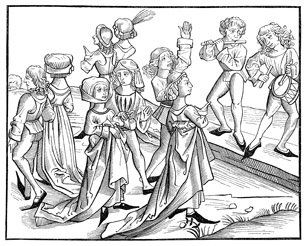
Since pre-Christian times, the summer solstice has been celebrated with seasonal rituals of major importance. Here are six fun facts you might not know about the summer solstice:
- The summer solstice is the longest day of the year in the Northern Hemisphere. A scientific explanation.
- In earlier times, the summer solstice was called Midsummer – not the start of summer as it is now.
- The eve of summer solstice was considered among the year’s scariest days — a time when fairies and evil spirits ran amuck. “Midsummer Eve is counted or called the Witches’ Night: and still in many places … they make Fires on the Hills.” John Aubrey, Remains of Gentilism, 1688
- It was customary to build giant bonfires on the solstice. People danced around the fires, and led their livestock, sons and daughters over the flames to keep them safe. Wheels of fires were rolled down hills to represent the sun. Even King Henry VII and Henry VIII of England had solstice fires in the great halls tended by pages and grooms.
“…there were usually made bonfires in the streets,
every man bestowing wood or labour towards them:
the wealthier sort … would set out tables …
furnished with sweet bread and good drink.”
John Stow, 16th century
- The timing of the solstice (late-June) was key. As Ronald Hutton writes in The Stations of the Sun, the solstice “preceded the season at which crops would be most vulnerable to weather or blight, and livestock to their diseases. It also ushered in the months in which insects multiplied most widely and in which, therefore, humans were most likely to contract bubonic plague, typhus, and malaria. The fires . . . were therefore deployed against serious dangers, and anxieties.”

- Certain flowers and herbs were said to have protective powers. St. John’s wort, mugwort, rosemary, elder, plantain, ivy and yarrow were some plants made into garlands and hung on the door to keep the home safe.
“The virtue of St. John’s Wort is thus. If it be put in a man’s house,
there shall come no wicked sprite therein.”
Banckes Herbal, 1525
More information from Seasonal Wisdom about the summer solstice.
Learn more from the sources used for this post: The Stations of the Sun, The Perpetual Almanack of Folklore, and The Oxford Book of Days











{ 9 comments }
What a wonderful distillation of the day. I always feel like I should celebrate it in some way.
It's great to see someone blog about the Summer Solstice. Your post is very informative and right on topic. I have been collecting as many protective plants as I can get my hands on, so this was of special interest to me. Thank you — well done!
Susan: Thanks for stopping by. I agree – there's something very festive about such an important seasonal day. Happy solstice. Teresa
Appreciated your comments, Alexandria. Glad to know you have all those "protective" plants in your garden. A good thing they are so pretty and that many taste delicious too… Thanks for stopping by. Teresa
Great post. Again.
Fun post. I’m running out to get some St. John’s Wort now. 😉 Summer solstice is my favorite holiday, but I wish it were still called midsummer. Wouldn’t it be nice to have a few extra weeks of summer?
Thanks Marie! Isn’t it interesting how certain plants were believed to have protective powers. I wish we still called today “Midsummer” too… All the best to you this summer. Teresa
Teresa, you always have something new and interesting to tell us about the seasons. Thanks, Ms Seasonal Wisdom!
Why, thank you, Helen! As they say, history is stranger than fiction… Happy summer to you in Toronto. Teresa
Comments on this entry are closed.
{ 1 trackback }